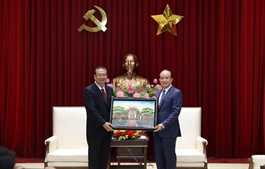Enterprises continue to fight financial difficulties
Enterprises continue to fight financial difficulties
Economic complexities have caused a reduction in Vietnam’s state budget revenues so far this year, with an expansion in expenditure largely induced by a rise in public investment disbursement.

The General Statistics Office (GSO) reported that in the first 10 months of this year, Vietnam’s total state budget revenue sat at $59 billion, down 9.2 per cent on-year. Domestic revenues are estimated to stand at nearly $48.84 billion, down 5.9 per cent on-year. The nine-month reduction rate was only 3.2 per cent on-year – meaning enterprises are facing mounting problems.
Enterprises continue to fight financial difficulties, illustration photo/ Source: freepik.com
The 10-month revenues from crude oil exports, all coming from PetroVietnam, are estimated to sit at $2.16 billion, representing a drop of 19.8 per cent as compared to the same period last year.
The Ministry of Finance also reported that in the first 10 months of this year, state budget revenues from export and import activities are estimated to reach more than $7.96 billion, down 21.9 per cent on-year. This means businesses are facing massive difficulties and have been finding it hard to boost exports and imports, the ministry said.
In the first 10 months, total export turnover hit an estimated nearly $291.3 billion, down 7.1 per cent as compared to the corresponding period last year. In which Vietnamese exporters raked in nearly $77.1 billion – down 4.1 per cent and accounting for 26.5 per cent of total export turnover, while foreign-invested exporters fetched nearly $214.2 billion (including crude oil exports) – down 8.1 per cent and occupying 73.5 per cent.
In an example, mobile phones and their spare parts, whose about 90 per cent are from Samsung, are estimated to earn a 10-month export turnover of over $44 billion, down 12.6 per cent on-year.
Many key export items witnessed an on-year 10-month reduction in revenue, such as machinery and equipment ($35.5 billion – down 7.1 per cent), garments and textiles ($27.8 billion – down 12.5 per cent), footwear ($16 billion – down 20.2 per cent), and wood and wooden products ($10.82 billion – down 19.9 per cent).
National Assembly deputy Pham Hung Thang representing the northern province of Ha Nam said. “Since early this year, there has been a big unemployment situation in industrial zones, meaning enterprises have either reduced operations or halted operations, so they have no money to contribute to the state budget.”
“We see that the state budget revenue scale has been scaling down as compared to the same period last year, and bad debts are even on the rise,” Thang added.
Total state budget revenues in the first 10 months of 2022 reached $61.8 billion – up 16.2 per cent on-year.
Meanwhile, the 10-month state budget spending has also witnessed an on-year rise of 11.4 per cent to an estimated sum of $57.3 billion. All types of expenditures continued to climb.
Notably, disbursement of public investment hit $16.95 billion, up 5.5 per cent on-year, and reaching 56.74 per cent of the initial plan assigned by the prime minister. Especially, disbursement in October alone hit $2.37 billion – far higher than the average of $1.68 billion in each month of the first 10 months of this year.
“Disbursement of public investment capital has changed dramatically, actively supporting economic growth, creating jobs and output for many sectors. At the same time, it has helped expand production capacity, contributing to creating bigger momentum for growth and development in the medium and long term,” said Minister of Planning and Investment Nguyen Chi Dung at a government meeting on Vietnam’s socioeconomic situation in Hanoi at the end of October.
“These results show the solutions on boosting disbursement of the 2023 capital investment plan are proving to be effective,” Minister Dung said.
The government has set a target that in 2024, total state budget revenue and expenditure will be about $69.62 billion and $86.47 billion, respectively – with a state budget deficit of $16.85 billion or about 3.6 per cent of GDP.



























